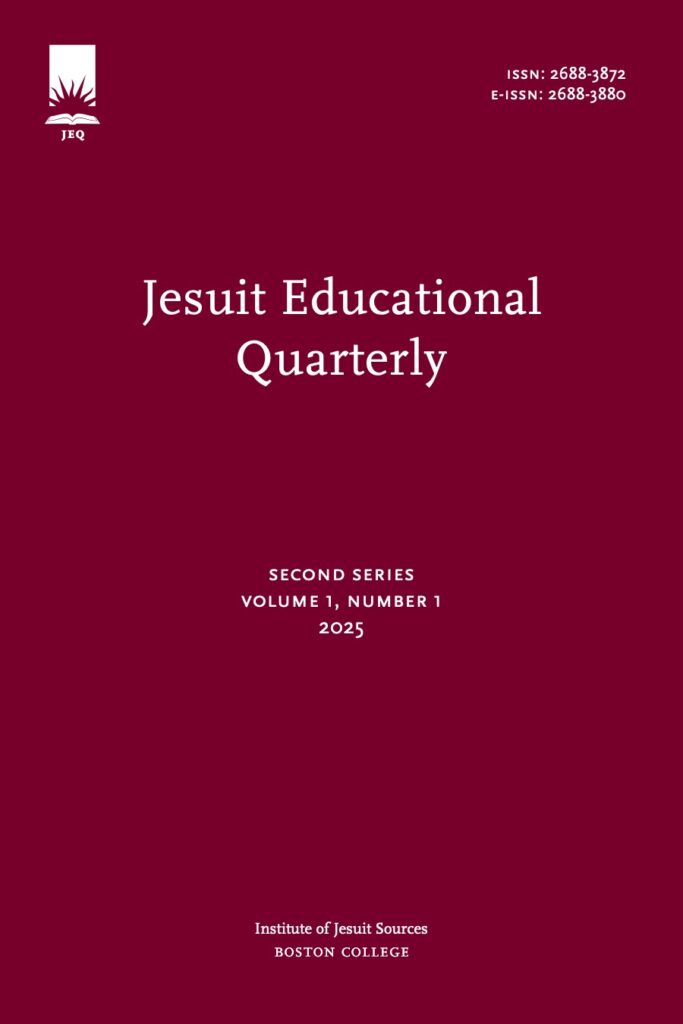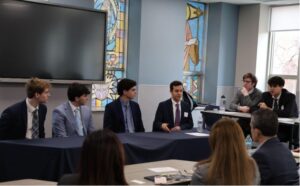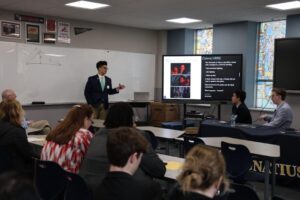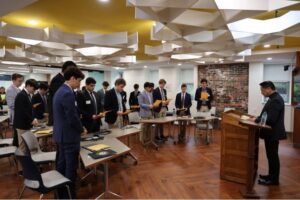Reflections on the Living Tradition
Living Our Jesuit Mission and Cultivating Communities of Faith: The Genesis of the High School Research Symposium
Caputo, Terra A. “Living Our Jesuit Mission and Cultivating Communities of Faith: The Genesis of the High School Research Symposium.” Jesuit Educational Quarterly, 2nd ser., 1, no. 2 (2025): 219–227. https://doi.org/10.51238/BCJovzP.
The 2018 Synod on Youth and Vocational discernment recognizes the importance of the perspectives of the young. We stand at their side. We glimpse the future with them. We walk with them in order to perceive and discern where the Spirit is leading our world and our Church.
—The Society of Jesus
Meek young men grow up in libraries, believing it their duty to accept the views which Cicero, which Locke, which Bacon have given, forgetful that Cicero, Locke and Bacon were only young men in libraries when they wrote these books.
—Ralph Waldo Emerson
In the AP Seminar class that I teach, I sometimes ask my students to imagine which famous people from history would have the most fascinating dinner table conversations. The course invites students to identify and engage with the meaningful but challenging nuances of academic conversation. By confronting and closely examining those nuances, students begin to understand the deep complexity of the world in which they live—and the challenges they will face as they grapple with that complexity. One strategy that helps them conceptualize the debates that lead to such complexity is asking them to design intellectual “match-ups” between some of the historical giants that they believe have changed the world.
Over the years, my students have proposed countless unique and compelling match ups: Steve Jobs and Alexander Graham Bell, Karl Marx and Adam Smith, Genghis Khan and Mahatma Gandhi.[1] Each year, without fail, Jesus tops the “most-mentioned” list, though he sees new proposed “match ups” as the tides of culture, politics, and life push and pull in new directions. Personally, if I could transport any two historical figures to my dinner table and bear witness to their conversation, I would choose Saint Ignatius of Loyola and Ralph Waldo Emerson. (Significant) theological differences aside, they exercised uncannily parallel core values. Both challenged convention by embracing a more individualized approach to spirituality. They rooted the experience of conversion in practices of personal reflection and retreats to natural spaces. Perhaps most significantly, both recognized that the path to higher truth lies in a deep and authentic interiority that must confront and reject the disordered attachments of the world. I like to think of Ignatius and Emerson as kindred spirits, both seeking to more deeply understand how human beings might live more purposeful, interiorly aware, and spirituality rooted lives. Significantly, both Emerson and Ignatius were willing to challenge the status quo—of their own lives and the lives of others—to ultimately work to make the world a better place.
A belief in the power of young people in particular to positively impact the world drives contemporary Jesuit education. The most recent Universal Apostolic Preferences (UAPs) of the Society of Jesus[2] foreground the fundamental value of the youth to advance our mission of building a hope-filled future. The language describing this third Apostolic Preference is worth considering at length:
It is the young who, from their perspective, can help us to understand better the epochal change that we are living and its hope-filled newness . . . we are living through a period of change from which will emerge a new humanity and a new way of structuring human life in its personal and social dimensions. Young people are the bearers of this new form of human life that can find, in the experience of encounter with the Lord Jesus, light for the path toward justice, reconciliation, and peace. The apostolic works of the society of Jesus can make an important contribution to creating and maintaining spaces that are open to young people in society and in the Church. Our works seek to be spaces open to youthful creativity, spaces that foster an encounter with the God of life revealed by Jesus and deepen the Christian faith of the young. Such spaces should help young people discern the path by which they can achieve happiness by contributing to the well-being of all mankind.[3]
The spirit of accompanying young people to co-create a hope-filled future has served as both an anchor and a compass for our work at the Center for Ignatian Pedagogy (CIP). The CIP, founded in 2022 as part of the school’s strategic initiative to promote academic excellence, is an in-house research center and learning lab that studies the cognitive, affective, and behavioral growth and wellness of adolescent boys.[4] Our primary mission is to empower student-faculty research teams to collaborate and design more notably Ignatian, evidence-based, and inspired teaching and learning.[5]
Figure 1. Evan Solar, Jad Alsouss, Michael Koury, and Andrew Hutter, senior research fellows at Saint Ignatius High School, present their original research on reciprocal feedback loops.
The most fruitful—and unique—component of our research agenda in the CIP has been the centrality of student experience, voice, and innovation in the design and implementation of classroom research. Our research agenda is not established top-down by the administration or even by the director of the center. Rather, a team of student research fellows identify key “problems of practice” that create obstacles in their own learning experiences. They then research and select high-impact, evidence-based, yet creative solutions that they believe, based on their real classroom learning contexts, would deepen learning. Students present their proposals to teams of teachers interested in testing high-impact strategies in their classrooms, and then teachers and students work collaboratively to develop an implementation plan, test strategies, and collect and analyze data to evaluate impact.[6]
Taking the leap and empowering students as partners in our research, professional learning, and school improvement efforts required an initial leap of faith that has illuminated the wisdom of the third UAP. Creating space to professionalize, legitimize, and deputize our students’ lived experiences in service of improved teaching and learning has drawn us into more authentic relationship with—and promoted a more widespread understanding of—our mission as a Jesuit school.
That same belief in the power of student voice led us to create and host the first High School Research Symposium on our campus this spring, in March 2025. The need for community-building academic spaces like the one offered in the symposium is widely validated throughout seminal works on Ignatian spirituality and pedagogy. From the Ratio studiorum[7] to Characteristics of Jesuit Education[8] and its more practical iteration, Ignatian Pedagogy: A Practical Approach,[9] the call for students to extend their intellectual pursuits beyond the walls of the classroom persists. Núñez and Lozano argue for a return to intellectual community engagement, a practice underscored in the Ratio but often watered down or even neglected in contemporary educational settings.[10]They argue that even for secondary students “a focus on an educative community that learns together, and a will to engage with various stakeholders at the setting in which the education institution is located,” which are “not peripheral to Jesuit pedagogy but rather are an intrinsic part of it.”[11]
Figure 2. Alec Dabney, a student from St. Edward High School in Lakewood, OH, presents his original research on portrayals of racial prejudice in film.
Though it was written more than 400 years ago, its emphasis on building community is just as—if not more—relevant today. The Ratio calls teachers to work to “forge a strong sense of belonging that goes beyond the classroom.”[12] Kolvenbach’s Characteristics of Education upholds the value of building vibrant spaces for faith-based intellectual exchange, noting, “to aid in promoting this interchange of ideas and experiences an exchange of teachers and students is encouraged wherever possible.”[13] Saint Ignatius of Loyola recognized and modeled this practice in his own life, showing us that one cannot sit in the cave indefinitely. Had Saint Ignatius remained in spaces of solitude, sequestering his conversion revelations within his own heart, how different our schools—and the Church—would be.
The first annual High School Research Symposium affirmed how hopeful the future can look when young people are empowered to step out of the silos of the classroom, like Ignatius from the cave at Manresa. Led and moderated by our student research fellows, the event was open to any high school student in the diocese of Cleveland who wished to present their original research. We sought to welcome a diverse group of students and research projects to the event. Achieving diverse representation enabled a remarkably vibrant interchange of ideas and dialogue among an impressive group of emerging scholars. In many ways, the event was a reminder that, while our individual schools have missions, the more significant truth is that our mission has schools. Our Jesuit charism lights our way, but the destination is shared with our Holy Cross, Josephite, and Benedictine schools. Our common Catholic mission calls us to walk together toward that hope-filled future.
We intentionally structured the research symposium as a professional conference: a formal venue for high school students to present, hear, and dialogue about original research central to our Catholic mission. The students presented across a wide range of disciplines and topics, integrating research from psychology, natural sciences, film criticism, educational research and policy, architecture, and linguistics and culture. Yet a powerful and compelling throughline connected each researchers’ projects: each of them took up issues relevant to our lives as Catholics and our shared mission to co-create God’s vision for this world.
The symposium structure upheld our commitment to engage in faith-based community building and cultivate solidarity for our mission among young people across the diocese. The day began with an inspiring prayer for researchers led by our President and an opening keynote that reminded presenters of the infinite potential awaiting them when they have the courage to use their voice in service of a better world. The bulk of the day was built around a series of concurrent sessions and panels featuring research teams and individual presenters organized into panels around key themes. Each presentation fulfilled the promise of the opening keynote, as students confronted with passion a range of complex issues facing our world: the impact of parental incarceration on children, shifting linguistic norms and its impact on preserving cultural tradition, the relationship between landscape architecture in urban spaces and citizens’ mental and physical health, wellness programs for teens’ vitality, and representations of racial prejudice in film, among others. Though the presentations were impressive in their own right, it was the dedicated time for dialogue with the audience, and with one another, at the conclusion of each panel that elevated the experience from simply presenting one’s ideas to truly building community. In those honest and inspired dialogic spaces, students, moderators, and parents cultivated thoughtful opportunities to collectively reimagine the world and its possibilities. Witnessing this event made concrete for me what it means to accompany young people and prepare them—alongside adults—for life.
Figure 3. Father Raymond Guiao, President of Saint Ignatius High School, leads presenters in an opening prayer.
Before I began teaching in a Jesuit school, the richness of my students’ thinking tended to stay siloed off from the world. They often produced work that had the potential to impact the world: their ideas carried wisdom, insights, and innovations worthy of broader engagement. For much of my teaching career, I’ve found myself hoping and trusting that the seeds I plant and my students cultivate will grow into meaningful, purposeful action in their lives. As the director of the Center for Ignatian Pedagogy at Saint Ignatius, I have the privilege to witness all that is possible when students’ voices are catapulted into the public sphere. Young people—along with the Church that they serve and the many rich spaces in which they have potential to lead with wisdom and passion—light up when they are entrusted to bring the full scope of their gifts fully to the table.
Hosting the High School Research Symposium is just one small step we have taken to bridge the gap between learning and life, between the classroom and making that hope-filled future a reality. As Emerson wisely said, “each age . . . must write its own books; or rather, each generation for the next succeeding.”[14] My hope is that we can continue to build these kinds of opportunities for young people so that they can take on the challenges of life and be guided by their faith and thereby answer the ultimate question: “What does God want for and from me?”[15]
Further Reading:
Kundu, Anindya. The Power of Student Agency: Looking Beyond Grit to Close the Opportunity Gap. New York: Teachers College Press, 2020.
Núñez, Alberto, S.J. and Josep M. Lozano. “Jesuit Pedagogy’s Missing Link.” Jesuit Higher Education 13, no. 1 (2024): 16–36. https://doi.org/10.53309/2164-7666.1436.
Sosa, Arturo, S.J., “Universal Apostolic Preferences of the Society of Jesus, 2019–2029.” Letter to the Whole Society, February 19, 2019. https://www.jesuits.global/sj_files/2020/05/2019-06_19feb19_eng.pdf.
Notes:
[1] Match up credit for these pairings goes to Matthew Mudryy, Joseph Haddad, and Alexander Nassar, current students at Saint Ignatius High School.
[2] Following a 16-month process of collective discernment that involved Jesuits from around the world, the Society of Jesus published a new set of Universal Apostolic Preferences, which are to serve as guideposts for how we are to best support the Lord’s mission and serve the church given the world’s current contexts and needs. The Society established four new UAPs at the end of its most recent discernment process in 2019: showing the way to God through the Spiritual Exercises and their practice of discernment; walking with the poor, the outcasts of the world, and those whose dignity has been violated, in the mission of reconciliation and justice; walking together with young people, to build a hope-filled future; and working together to care for the earth, our common home. See Arturo Sosa, S.J., “Universal Apostolic Preferences of the Society of Jesus, 2019–2029,” Letter to the Whole Society, February 19, 2019, accessed March 31, 2025, https://www.jesuits.global/sj_files/2020/05/2019-06_19feb19_eng.pdf.
[3] Sosa, “Universal Apostolic Preferences.”
[4] The Center for Ignatian Pedagogy was the first concrete initiative developed out of Vision ’30, Saint Ignatius High School’s current strategic plan. The plan provides a “spirit-led” road map that guides our work as a school for the next generation of Ignatius students. See “The Campaign for Vision ’30: Our Hope, Our Future,” Saint Ignatius High School, 2020, https://www.mydigitalpublication.com/publication/?i=817686.
[5] All photos included in this article were taken at the High School Research Symposium at Saint Ignatius High School on March 15, 2025. Photograph credit to Maura McGrath, Communications Department at Saint Ignatius High School.
[6] For more about the student and teacher fellows program at Saint Ignatius High School, see “Research Fellows Program,” Center for Ignatian Pedagogy at Saint Ignatius High School, accessed March 31, 2025 https://www.ignatius.edu/academics/center-for-ignatian-pedagogy/research-fellows-program.
[7] The Ratio prescribes in its “Rules of the Academy and of Students of Rhetoric and Humanities” student presentations to develop their skills in eloquent expression, and dictates that “it will be found worthwhile occasionally to have some of the better and more ambitious of these exercises or prelections, declamations, and defenses of theses presented, especially by the president of the academy, with a degree of external ceremony in the presence of a distinguished audience.” See The Jesuit Ratio Studiorum of 1599, trans. Allan P. Farrell, S.J. (Conference of Major Superiors of Jesuits, 1970), 110–11, https://www.educatemagis.org/wp-content/uploads/documents/2019/09/ratio-studiorum-1599.pdf.
[8] The notion of learning rooted in community and connection pervades Kolvenbach’s work, as does the notion of cultivating student eloquence and skills in written and oral communication. In particular, See Peter Hans Kolvenbach, The Characteristics of Jesuit Education (1886), 7, retrieved from https://www.educatemagis.org/documents/the-characteristics-of-jesuit-education-en/.
[9] The 1993 document, Ignatian Pedagogy: A Practical Approach attempts to consolidate the more theoretical descriptions of Ignatian pedagogy from earlier works published by the Society of Jesus into a practical, concrete framework that highlights iterative cycles of experience, reflection, and action to form competent, confident learners who are well prepared to act in the world with meaning and purpose. See Ignatian Pedagogy: A Practical Approach (The International Center for Jesuit Education, 1993), retrieved from https://www.educatemagis.org/wp-content/uploads/2015/02/Document_on_Ignatian_Pedagogy_-_English.pdf.
[10] See Alberto Núñez, S.J., and Josep M. Lozano, “Jesuit Pedagogy’s Missing Link,” Jesuit Higher Education 13, no. 1 (2024): 16–36, https://doi.org/10.53309/2164-7666.1436.
[11] Núñez and Lozano, “Jesuit Pedagogy’s Missing Link,”16.
[12] Núñez and Lozano, “Jesuit Pedagogy’s Missing Link,” 26.
[13] Kolvenbach, The Characteristics of Jesuit Education, 29.
[14] See Ralph Waldo Emerson, The American Scholar (New York: The Laurentine Press, 1901 [1837]), 14.
[15] Robert J. Welsh, S.J. (1936–2018) led Saint Ignatius High School as president from 1979–2000. His articulation of our school’s true mission and purpose are not etched in stone in the middle of campus, where 1400 students can walk each day and be reminded that: “The purpose of our education is to give a young man the tools whereby he can answer the question What does God want from me?” This reflection and the work of the CIP are written in memory of Welsh and his legacy. Our hope is that we can continue to carry forward his mission and help young people—both in and beyond our community—to use their gifts for the greater glory of God.
Emerson, Ralph Waldo. The American Scholar. New York: The Laurentine Press, 1901 [1837].
Center for Ignatian Pedagogy. “Research Fellows Program.” Cleveland: Saint Ignatius High School, 2023. https://www.ignatius.edu/academics/center-for-ignatian-pedagogy/research-fellows-program.
Ignatian Pedagogy: A Practical Approach. Rome: The International Center for Jesuit Education, 1993. Retrieved from https://www.educatemagis.org/wp-content/uploads/2015/02/Document_on_Ignatian_Pedagogy_-_English.pdf
The Jesuit Ratio Studiorum of 1599. Translated by Allan P. Farrell, S.J. Conference of Major Superiors of Jesuits, 1970. https://www.educatemagis.org/wp-content/uploads/documents/2019/09/ratio-studiorum-1599.pdf.
Kolvenbach, Peter-Hans, S.J. The Characteristics of Jesuit Education, 1886, retrieved from https://www.educatemagis.org/documents/the-characteristics-of-jesuit-education-en/.
Núñez, Alberto, S.J. and Josep M. Lozano. “Jesuit Pedagogy’s Missing Link.” Jesuit Higher Education 13, no. 1 (2024): 16–36. https://doi.org/10.53309/2164-7666.1436.
O’Malley, John W. “Jesuit Schools and the Humanities: Yesterday and Today.” Studies in the Spirituality of the Jesuits 41, no. 1 (2015): 1–33. https://doi.org/10.6017/ssj.v47i1.5924.
Saint Ignatius High School. “The Campaign for Vision ’30: Our Hope, Our Future.” Cleveland: Saint Ignatius High School, 2020. https://www.mydigitalpublication.com/publication/?i=817686.
Sosa, Arturo, S.J., “Universal Apostolic Preferences of the Society of Jesus, 2019–2029.” Letter to the Whole Society, February 19, 2019. https://www.jesuits.global/sj_files/2020/05/2019-06_19feb19_eng.pdf.
- Title: The Predicament of Jesuit Higher Education
- Author: Terra A. Caputo
- Article Type: Reflections on the Living Tradition
- DOI: https://doi.org/10.51238/BCJovzP
Language: English - Pages: 219–227
- Keywords: –
- In: Jesuit Educational Quarterly
- In: 2nd ser., Volume 1, Issue 2
- Received: 21 March 2025
- Accepted: 24 March 2025
- Publication Date: 28 April 2025
Last Updated: 28 April 2025 - Publisher: Institute of Jesuit Sources
- Print ISSN: 2688-3872
- E-ISSN: 2688-3880
APA
Caputo, T. A. (2025). Living our Jesuit mission and cultivating communities of faith: The genesis of the high school research symposium. Jesuit Educational Quarterly, 1(2), 219–227. https://doi.org/10.51238/BCJovzP
CMOS
Caputo, Terra A. 2025. “Living Our Jesuit Mission and Cultivating Communities of Faith: The Genesis of the High School Research Symposium.” Jesuit Educational Quarterly, 2nd ser., 1, no. 2: 219–227. https://doi.org/10.51238/BCJovzP.
MLA
Caputo, Terra A. “Living Our Jesuit Mission and Cultivating Communities of Faith: The Genesis of the High School Research Symposium.” Jesuit Educational Quarterly, 2nd ser., vol. 1, no. 2, 2025, pp. 219–227. https://doi.org/10.51238/BCJovzP.
Turabian
Caputo, Terra A. 2025. “Living Our Jesuit Mission and Cultivating Communities of Faith: The Genesis of the High School Research Symposium.” Jesuit Educational Quarterly, 2nd ser., 1, no. 2: 219–227. https://doi.org/10.51238/BCJovzP.
© Institute of Jesuit Sources, Institute for Advanced Jesuit Studies, All Rights Reserved







